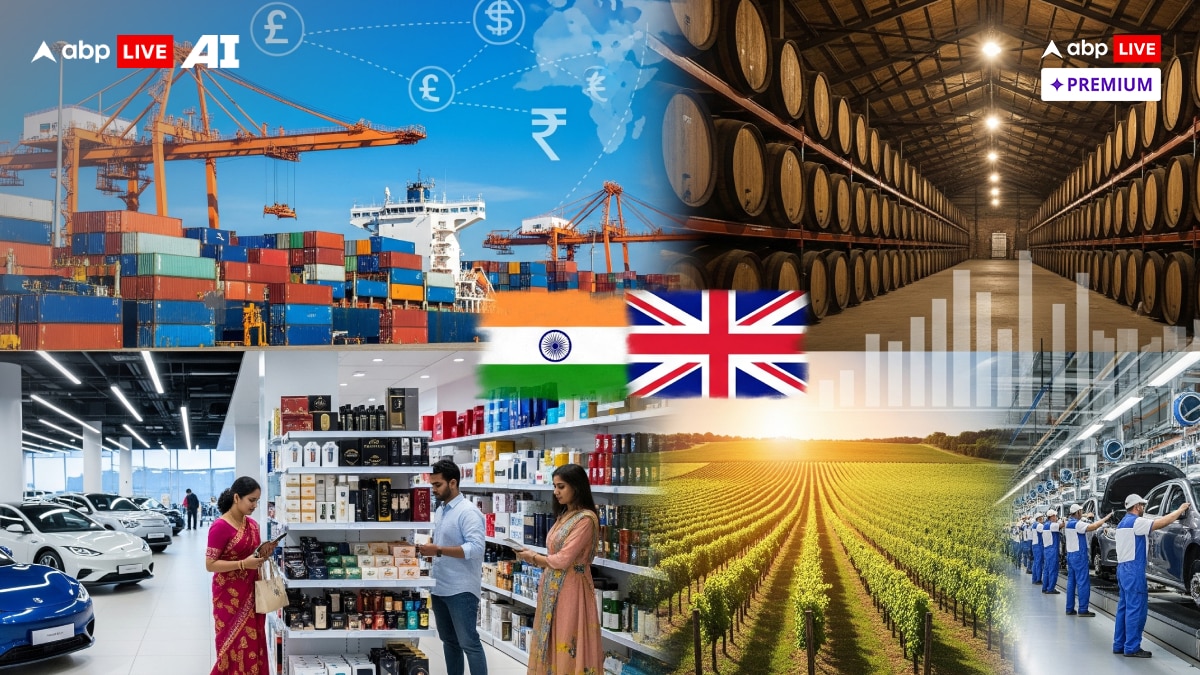
<p>The India-UK free trade agreement (FTA), signed on July 24, has set the stage for unleashing the animal spirits in the trade and business relationship between the two countries which have decided to reduce tariffs on UK whisky from 150 per cent to 40 per cent over 10 years, as part of a comprehensive deal to eliminate tariffs on 90 per cent of current UK exports to India, with 85 per cent becoming completely tariff-free over the next decade.</p>
<p>Overall, this means around 90 per cent of current UK goods trade will enter India at greatly reduced tariffs once the FTA comes into effect, and 85 per cent of these products will become completely tariff-free over the next 10 years, even as concerns rise over steep revenue losses as tariffs get reduced.</p>
<p>For UK consumers, the FTA will make nearly 99 per cent of Indian exports duty-free, particularly benefiting sectors like clothing, footwear and jewellery, which currently comprise 14.4 per cent of UK jewellery imports, as well as frozen shrimp, which makes up for 23 per cent of UK imports. The deal paves the way for more affordable options and greater consumer choice.</p>
<p>Britain is the sixth-largest investor in India. The country has received $35.3 billion FDI during April 2000 and September 2024. The FTA is further expected to increase investment of UK businesses in India and vice versa.</p>
<p>In FY 2024–25, India’s exports to the UK grew by 12.6 per cent to $14.6 billion, while imports increased 2.3 per cent to $8.6 billion, taking total goods trade to $23.2 billion, points out S C Ralhan, President of the Federation of Indian Export Organisations (FIEO). </p>
<p><img src=”https://feeds.abplive.com/onecms/images/uploaded-images/2025/07/31/a7ffb87d48975561c18b721b92aa3a8c1753950296978402_original.jpg” width=”720″ /></p>
<h3><span style=”color: #ba372a;”><strong>Win-Win For Auto </strong></span></h3>
<p>The FTA route to an ambitious expansion of trade to $120 billion by 2030 set by both trade partners includes meeting the aspirations of consumers in the world’s third largest automobile market with UK cutting levies on automobiles from 110 per cent to 10 per cent and eliminating duties on personal care products and confectionery, making these products more accessible to India’s growing middle class.</p>
<p>Data from BMI (a Fitch Solutions company) shows British car exports to India are currently starting off from a low base, with only $188.7 million worth of vehicles exported from the UK to India in 2024, a decrease from the $205.4 million exported in 2023.</p>
<p>In 2025, 5.5 million vehicles were sold across India. By 2033, this will grow to just over 9.0mn vehicles sold. Capturing even a small share of this will be lucrative for an auto manufacturer. </p>
<p><img src=”https://feeds.abplive.com/onecms/images/uploaded-images/2025/07/31/769a021ea74af6088f293f5972bf06211753950413402402_original.jpg” width=”720″ /></p>
<p>“The commitments made by the Government of India on automobile sector tariffs strike a thoughtful balance,” says Shailesh Chandra, President, SIAM and Managing Director of Tata Passenger Vehicles. “We view this agreement as part of a wider strategic engagement and believe it opens new avenues for collaboration and opportunity with a key global partner,” adds Chandra.</p>
<p>The reduction of trade tariffs bodes well for India’s consumer sector going forward.</p>
<p><img src=”https://feeds.abplive.com/onecms/images/uploaded-images/2025/07/31/eb001578412ea8a1dd84029fb55615ff1753950717667402_original.jpg” width=”720″ /></p>
<p>The Indian consumer will see strong growth in real wages over the medium term as real household incomes are expected to grow by 5.1 per cent YoY annually from 2025 to 2029, and the burgeoning middle class will increasingly be able to support a wider array of products imported from the UK.</p>
<h3><span style=”color: #ba372a;”><strong>Bumps Ahead</strong></span></h3>
<p>The signed pact will still need to be ratified by both parties before businesses can trade under its terms, but expert views from BMI foresee no hindrance in the progression of the FTA due to the incumbent Labour Party’s strong majority in the UK House of Commons.</p>
<p>India will also have to brace for an estimated revenue loss from the FTA with the UK, as tariffs are reduced or eliminated on a wide range of traded goods, with a dip in customs revenue for both governments looking imminent, according to Ajay Srivastava, Founder, Global Trade Research Initiative (GTRI).</p>
<p>The GTRI insight points out that India imported $8.6 billion worth of goods from the UK in FY25. Industrial products make up the bulk of these imports and face a weighted average tariff of 9.2 per cent.</p>
<p>Most agricultural products, subject to much higher average tariffs of 64.3 per cent, were excluded from tariff cuts, except for items like whisky and gin. India has committed to eliminating tariffs on 64 per cent of the value of imports from the UK immediately as the implementation starts.</p>
<p>Based on these factors, GTRI estimates India’s revenue foregone in the first year of the agreement at Rs 4,060 crore. By the 10th year, as tariff elimination phases in more broadly, the annual loss is projected to rise to Rs 6,345 crore based on FY2025 trade volumes. These figures are expected to increase as bilateral trade grows.</p>
<p>The UK is no exception to the prospect of revenue loss. India’s FTA partner imported $14.5 billion worth of goods from India in FY2025, with a weighted average import tariff of 3.3 per cent.</p>
<p>Under the FTA, the UK has agreed to eliminate tariffs on 99 per cent of Indian imports. This translates to an estimated annual revenue loss of $474 million for the UK, again based on FY2025 trade data. As Indian exports to the UK expand, the fiscal impact is likely to grow over time, cautions GTRI.</p>
<h3><span style=”color: #ba372a;”><strong>Ensuring Long-Term Interests</strong></span></h3>
<p>Going ahead, experts and industry are betting on the long-term dividends of the FTA. </p>
<p>Rumki Majumdar, Economist, Deloitte India, looks at the broader canvas of India’s acceleration in signing trade agreements to ensure that its labour-intensive sectors can capture a larger share of the demand from Europe and the shifting trade preferences.</p>
<p>Similarly, Pankaj Chadha, Chairman of the Engineering Export Promotion Council, is hopeful that the FTA’s elimination of tariffs, which previously reached up to 18 per cent on key engineering products, is expected to catalyse export growth. “EEPC India estimates that engineering exports to the UK could nearly double to over $7.5 billion by 2029–30,” says Chadha.</p>
<p>The agreement will particularly benefit Indian MSMEs by reducing entry barriers and enhancing competitiveness in the UK market, according to Chadha.</p>
<p>The agreement also delivers a significant win for India’s agriculture sector, as products like turmeric, cardamom, pepper, mango pulp, pickles, and pulses will now enjoy duty-free access to the UK, enhancing farmers’ market reach and profitability.</p>
<p>Additionally, Jewellery remains a key Indian consumer export to the UK. In 2024, the UK imported over $437 million worth of jewellery articles from India or about 14.4 per cent of all jewellery imports to the UK that year, spurred by the growth of the British Indian demographic as well as the wider Indian ethnic group in the UK.</p>








